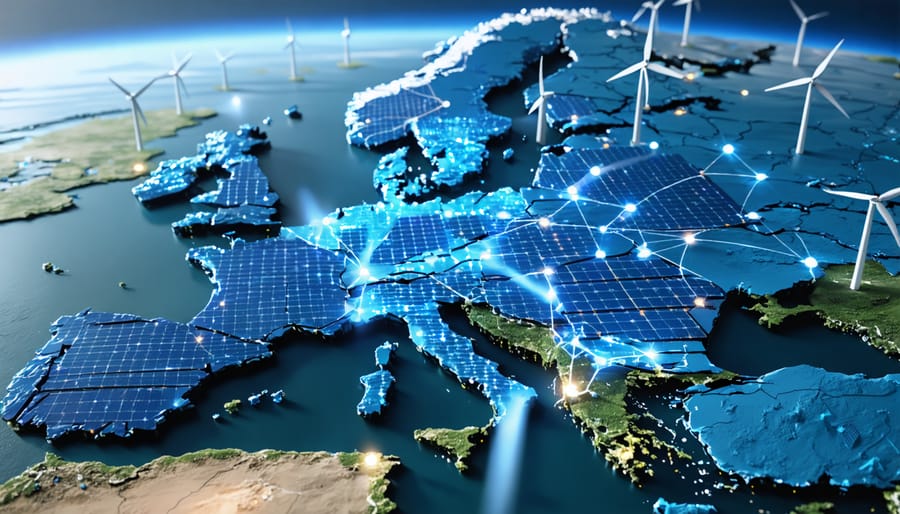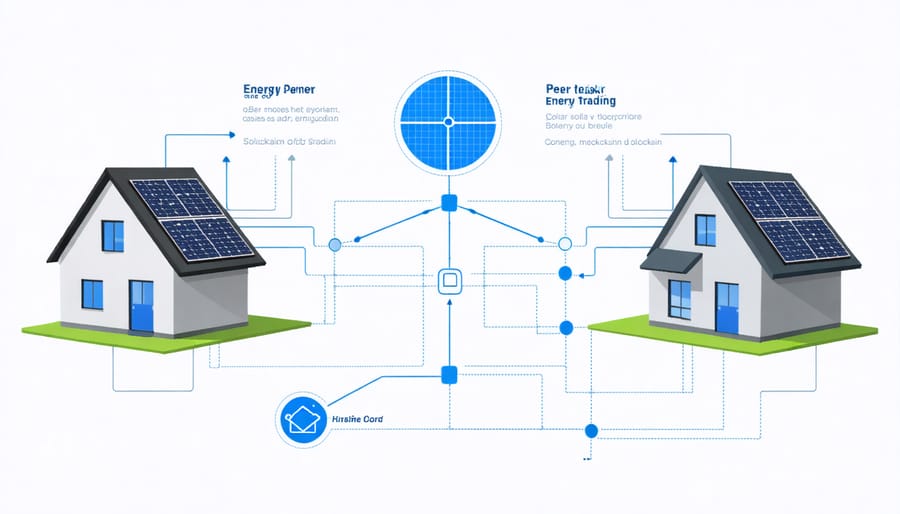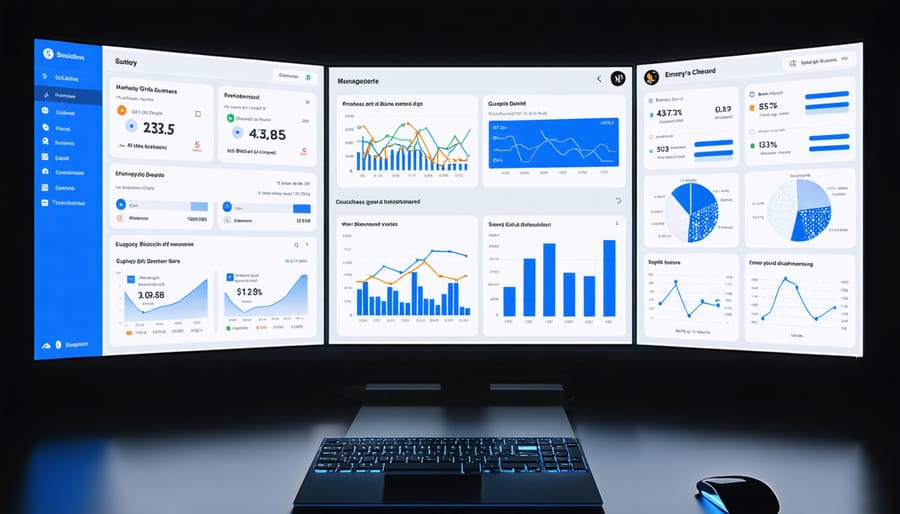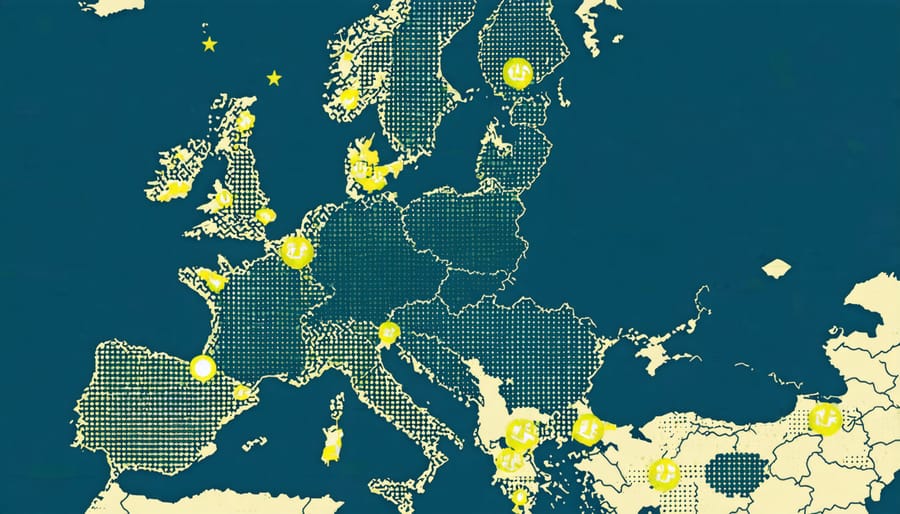Blockchain Technology Is Revolutionizing Europe’s Renewable Energy Markets

Blockchain technology is revolutionizing renewable energy markets across Europe, creating unprecedented opportunities for transparent, efficient, and decentralized power distribution. By enabling peer-to-peer energy trading and automated smart contracts, blockchain platforms are transforming how homeowners and businesses manage their renewable energy resources. This innovative convergence addresses critical challenges in the renewable sector, from grid stability and energy storage to real-time consumption tracking and carbon credit verification.
In countries like Germany and Denmark, blockchain-powered microgrids already demonstrate how distributed ledger technology can enhance energy efficiency while reducing costs. These systems enable direct energy trading between producers and consumers, eliminating intermediaries and creating more resilient energy networks. The technology’s immutable nature ensures transparent tracking of renewable energy certificates, providing irrefutable proof of green energy generation and consumption.
For European stakeholders, blockchain integration represents a crucial step toward achieving the EU’s ambitious renewable energy targets. The technology’s ability to facilitate automated grid management, instant settlements, and verified clean energy trading is particularly valuable as the continent transitions toward a more sustainable energy future. This transformation promises to democratize energy markets while ensuring the reliable integration of renewable sources into existing power infrastructure.
How Blockchain Strengthens Renewable Energy Networks
Decentralized Energy Trading
Blockchain technology is revolutionizing the way renewable energy is traded by enabling direct peer-to-peer transactions between energy producers and consumers. Modern blockchain energy trading systems allow homeowners with solar panels to sell their excess electricity directly to neighbors or local businesses, eliminating traditional intermediaries and reducing costs.
This decentralized approach creates a more dynamic and efficient energy marketplace where participants can automatically buy and sell energy based on real-time supply and demand. Smart contracts ensure transparent, secure transactions while maintaining detailed records of energy production and consumption. For example, a household in Germany can sell surplus solar power to a nearby business during peak production hours, with payments processed automatically through the blockchain.
The system’s transparency and automation have particular relevance in European markets, where energy communities are increasingly common. Participants can track their energy usage, trading history, and earnings through user-friendly interfaces, while the underlying blockchain technology ensures the integrity of every transaction. This innovation is particularly valuable for urban communities and industrial parks looking to optimize their local energy resources and reduce dependency on the main grid.

Smart Contract Automation
Smart contracts revolutionise renewable energy transactions by automating the buying, selling, and settlement processes between producers and consumers. These self-executing digital agreements operate on blockchain technology, eliminating the need for intermediaries and reducing administrative overhead.
In the European energy market, smart contracts enable instantaneous peer-to-peer energy trading. When a solar panel owner generates excess electricity, the smart contract automatically records the production and manages the sale to nearby consumers. Payment processing occurs in real-time, ensuring immediate settlement and transparent pricing.
The automation extends to grid management as well. Smart contracts can regulate energy distribution based on demand, supply, and grid capacity. During peak production hours, these contracts efficiently allocate surplus renewable energy to where it’s needed most, optimising grid stability and reducing waste.
For businesses and homeowners, smart contracts simplify participation in energy markets. The technology handles complex billing cycles, regulatory compliance, and renewable energy certificate trading automatically. This automation not only reduces operational costs but also increases trust in the system through immutable record-keeping and transparent transactions.
As the European renewable energy sector grows, smart contract automation becomes increasingly vital for managing the complexity of decentralised energy systems efficiently and reliably.
Building Resilient Energy Systems with Blockchain
Grid Stabilization
Blockchain technology is revolutionizing grid stabilization by enabling real-time balancing of renewable energy supply and demand. Through smart contracts and distributed ledger systems, power producers and consumers can automatically adjust their energy flows based on current grid conditions.
The system works by creating a decentralized network where each participant—from solar panels on residential rooftops to large wind farms—continuously shares production and consumption data. This transparent, immutable record allows for instantaneous matching of supply with demand, reducing the risk of grid overload or power shortages.
In European markets, blockchain-powered grid stabilization has shown remarkable results. For instance, in Germany, several pilot projects have demonstrated how blockchain can coordinate thousands of solar installations and battery storage systems to maintain grid frequency within optimal ranges. When production exceeds demand, smart contracts automatically redirect excess energy to storage facilities or trigger demand response mechanisms.
The technology also enables microsecond-level response times to grid fluctuations, a crucial feature for managing the intermittent nature of renewable energy sources. During peak production periods, the system can quickly distribute surplus energy to where it’s needed most, while during low production periods, it can activate stored reserves or adjust consumption patterns.
For grid operators, this means enhanced visibility and control over the entire network, leading to improved stability and reduced need for conventional backup power plants. The result is a more resilient, efficient, and sustainable energy system that can handle the growing integration of renewable sources.

Disaster Recovery
Blockchain technology plays a crucial role in maintaining energy resilience during system disruptions, offering a robust framework for renewable energy networks to recover quickly from unexpected events. By distributing data across multiple nodes, blockchain creates a resilient system that continues to function even when individual components fail.
During natural disasters or technical failures, blockchain-enabled microgrids can automatically isolate affected areas while maintaining power distribution in functioning sections. This segmentation capability ensures that renewable energy systems remain operational in unaffected regions, minimizing the impact of localized disruptions on the broader network.
The technology’s immutable ledger system preserves critical operational data, enabling swift system restoration after disruptions. Smart contracts automatically execute predetermined recovery protocols, reducing downtime and ensuring rapid service resumption. For European businesses and communities, this means enhanced protection against power interruptions and more reliable renewable energy supply.
Furthermore, blockchain’s peer-to-peer trading capabilities allow energy resources to be redirected quickly during emergencies, creating flexible distribution networks that can adapt to changing conditions. This adaptability is particularly valuable in regions prone to severe weather events or technical challenges, ensuring continuous power supply to critical infrastructure and essential services.

Real-World Applications in European Markets
Microgrid Projects
Several pioneering blockchain-powered microgrids across Europe demonstrate the transformative potential of this technology in renewable energy distribution. The Brooklyn Microgrid project in Germany serves as a stellar example, enabling neighbours to trade solar energy directly through smart contracts, reducing energy costs by up to 40% while ensuring transaction transparency.
In Switzerland, the Quartierstrom initiative has successfully implemented a local energy market in Walenstadt, where 37 households participate in autonomous energy trading. The project utilises blockchain technology to facilitate peer-to-peer energy transactions, with participants reporting a 28% increase in local renewable energy consumption.
The Netherlands’ Power to Share project in Rotterdam showcases how blockchain technology can optimise energy distribution in urban settings. This innovative system connects 200 households and businesses, allowing them to share excess solar power while maintaining secure, automated payment settlements through smart contracts.
Portugal’s Energia Simples microgrid project demonstrates blockchain’s ability to integrate multiple renewable sources. The system combines solar, wind, and battery storage solutions, serving a community of 150 households while reducing grid dependency by 35%.
These successful implementations highlight key benefits including:
– Automated peer-to-peer energy trading
– Reduced transaction costs
– Enhanced grid reliability
– Transparent energy pricing
– Improved renewable energy integration
– Real-time consumption monitoring
Such projects prove that blockchain technology can effectively democratise energy distribution while promoting sustainable practices in local communities.
Energy Trading Platforms
Several innovative blockchain-based energy trading platforms have emerged across Europe, revolutionising how renewable energy is bought, sold, and distributed. These platforms enable direct peer-to-peer (P2P) energy trading, allowing prosumers (producers-consumers) to sell their excess solar or wind energy directly to neighbours or local businesses.
Power Ledger, one of the pioneering platforms, has successfully implemented projects in several European countries, facilitating transparent and efficient energy transactions. The platform uses blockchain technology to create secure, automated trading environments where participants can trade renewable energy certificates and carbon credits alongside actual energy.
In Germany, the Brooklyn Microgrid model has been adapted to create local energy marketplaces, where community members can trade solar energy within their neighbourhood. This system utilises smart contracts to automate transactions and ensure fair pricing based on real-time supply and demand.
WePower, operating primarily in Baltic countries, has developed a standardised platform that enables renewable energy producers to tokenize and trade future energy production. This innovation helps businesses and households secure renewable energy at competitive prices while supporting new renewable energy projects.
Energy Web Foundation, a Swiss-based platform, focuses on creating standardised blockchain solutions for the energy sector. Their platform facilitates everything from renewable energy certificate trading to electric vehicle charging management, demonstrating the versatility of blockchain in energy applications.
These platforms typically feature user-friendly interfaces, automated settlement systems, and transparent pricing mechanisms. They employ smart meters and IoT devices to track energy production and consumption in real-time, ensuring accurate trading and billing.
Implementation Considerations for Businesses
Technical Requirements
Implementing blockchain technology in renewable energy systems requires a robust technical foundation. The core infrastructure consists of distributed ledger technology (DLT) nodes, smart meters with IoT capabilities, and secure communication protocols. Each participant in the energy network needs a digital wallet and authentication credentials to engage in energy transactions.
Smart contracts form the backbone of automated energy trading, requiring compatible software platforms and standardized protocols. The system must integrate with existing grid infrastructure through specialized APIs and middleware solutions. For optimal performance, the network should maintain a minimum connection speed of 10 Mbps and ensure consistent uptime through redundant systems.
Data storage requirements vary based on network size, but typically demand 1-2 TB of dedicated storage per node for transaction history and real-time energy data. Security measures include multi-signature authentication, encrypted communications, and regular security audits to protect against cyber threats.
Essential hardware components include:
– Blockchain-enabled smart meters
– Edge computing devices for real-time processing
– Network gateway devices
– Backup power systems
– Hardware security modules (HSMs)
The system architecture must support scalability, allowing for future expansion as more participants join the network. Regular maintenance and updates ensure system reliability and compliance with evolving European energy regulations. Integration with energy management systems (EMS) enables automated optimization of energy distribution and consumption patterns.
Regulatory Compliance
The European Union has established comprehensive regulatory frameworks to govern blockchain technology in renewable energy systems, with several key directives shaping the landscape. The Clean Energy Package and RED II (Renewable Energy Directive II) specifically address the integration of blockchain solutions in energy trading and management systems.
Member states must ensure that blockchain-based renewable energy platforms comply with GDPR requirements, particularly concerning data protection and user privacy. Energy companies implementing blockchain solutions need to maintain transparent records of transactions and ensure proper data handling protocols.
The European Energy Exchange (EEX) has introduced specific guidelines for blockchain-based energy trading, requiring platforms to demonstrate security measures, transaction verification protocols, and clear audit trails. Smart contracts used in energy trading must align with national contract laws and EU-wide regulations.
Compliance requirements also extend to cybersecurity standards, with the NIS Directive (Network and Information Security) mandating robust security measures for critical energy infrastructure. Organizations must conduct regular security assessments and maintain incident response plans.
For peer-to-peer energy trading platforms, regulators require clear documentation of energy origin, standardized measurement protocols, and verified renewable energy certificates. Companies must also ensure their blockchain solutions align with the EU’s sustainability goals, including energy efficiency requirements and carbon footprint considerations.
Local regulatory bodies in each member state may impose additional requirements, making it essential for organizations to conduct thorough compliance assessments before implementing blockchain solutions in renewable energy projects.
Blockchain technology stands poised to revolutionize the renewable energy sector across Europe and beyond, offering unprecedented opportunities for market transformation and sustainable growth. By enabling secure, transparent, and efficient energy trading, blockchain solutions are reshaping how we produce, distribute, and consume renewable energy.
The integration of blockchain with renewable energy systems has already demonstrated significant benefits, from reducing transaction costs to enabling peer-to-peer energy trading networks. These innovations are particularly relevant for European homeowners and businesses seeking to maximize their renewable energy investments while contributing to a more sustainable future.
Looking ahead, we can expect to see broader adoption of blockchain technology in renewable energy markets, driven by improving technological capabilities and supportive regulatory frameworks. The emergence of smart contracts and automated trading systems will further streamline energy transactions, while enhanced grid management capabilities will support the integration of distributed energy resources.
Key developments on the horizon include more sophisticated energy tracking systems, expanded peer-to-peer trading platforms, and innovative financing mechanisms for renewable energy projects. These advancements will likely accelerate the transition to renewable energy while creating new opportunities for market participants.
As we move forward, the combination of blockchain and renewable energy will continue to drive innovation in the energy sector, fostering a more resilient, efficient, and sustainable energy ecosystem for future generations. The technology’s potential to democratize energy markets while ensuring security and transparency makes it an essential tool in Europe’s clean energy transition.
Leave a Reply